Ventura County
Sphingidae
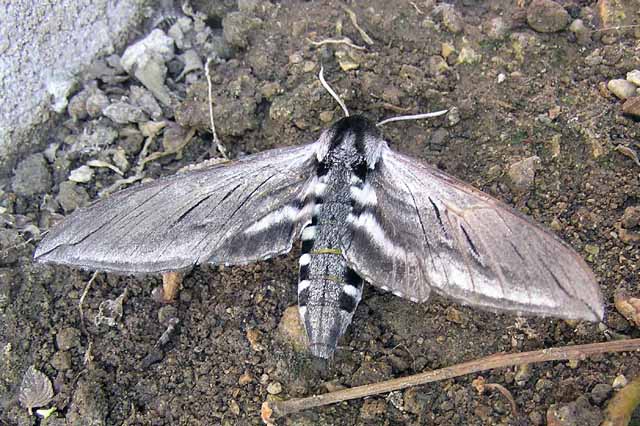
Sphinx perelegans *, August 1, 2004, courtesy of Mary Shepherd,
This page, inspired by Mary Shepherd, is
dedicated to Tom Dimock (TD)
of Ventura, California. Tom has been recording Sphingidae
sightings since 1964.
Thirty-two Sphingidae species are listed in the USGS for
California. Not all of the species are reported by USGS (nine species)
or anticipated in Ventura County.
It is hoped that this checklist, with the thumbnails and notes, will
help you quickly identify the moths you have encountered.
A WO" after the species name indicates that
I have no confirmed reports of this species in Ventura County, but I
(William Oehlke) expect that this moth is present.
A USGS indicates the
moth is reported on the USGS website and/or in Moths of Western
North America, #2. Distribution of Sphingidae of Western North America, revised,
an excellent little booklet available through Paul Opler.
Please help me develop this list with improved, documented accuracy by
sending sightings (species, date, location), preferably with an
image, via email to
Bill Oehlke.
* The Sphinx at the top of the page was
rescued by Mary Shepherd from certain death at the beaks of numerous
birds who were trying to catch it in Mary's garden in Fillmore (Ventura County),
California. The habitat is chaparral and oak woodland vegetation less
than a half-mile to the north and west and the Sespe River.
The moth has probably been mouthed by several of the birds as there is
significant scale loss on the forwewings. I (Bill Oehlke) did some
digital repair on the lower left wing.
Sphinx chersis, Sphinx perelegans and Sphinx vashti are
quite similar. Note the dark upper thorax with wide black bars
extending to the abdomen on the image of Sphinx perelegans.
In Sphinx chersis the entire thorax is uniform
light blue-grey with very narrow dark lines.
Sphinx vashti lacks the checkered fringe so evident on the
right hindwing of Mary's image.
Sphinginae subfamily
Sphingini tribe:
 |
This species has not been reported in Ventura County, but may be there as a stray.
The moth is a very
strong flier and is frequently encountered far north of its usual range.
|
 |
This large bodied moth flies in tobacco fields and vegetable gardens
(potatoes, tomatoes) and wherever host plants are found. |
 |
Manduca sexta
WO/TD, the Carolina Sphinx
This species is now recorded in Ventura
County, and it has been reported in neighbouring counties.
If you grow tomatoes, you have probably encountered it.
Larvae get very large and can strip a tomato plant. |
 |
Sphinx chersis
USGS/TD, the Northern Ash
Sphinx or Great Ash Sphinx
The upperside of the forewing is soft dark-gray to blue-gray with
a series of black dashes, one reaching the wing tip. Note grey
thorax with narrow black lines.
|
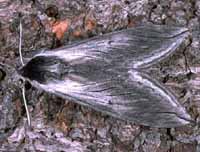 |
Sphinx perelegans adults fly in montane woodlands and mixed chaparral-type vegetation as a single brood
in the north, with adults mainly on the wing in June and July. Mary Shepherd
confirms August 1, 2004.
It flies from dusk until after midnight. Note dark thorax. |
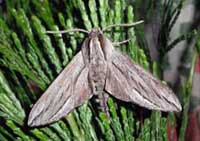 |
This species is now recorded in Ventura County.
Adults fly as a single brood in the desert and in pinyon-juniper
woodland from May to August. |
 |
Sphinx vashti
USGS/TD, the Snowberry Sphinx,
Snowberry Sphinx adults fly as a single brood in montane woodlands and along prairie
streamcourses from April to August, usually further
north.
The upperside of the forewing has a narrow black subterminal line
bordered by a white inverted V-shaped line on the outside, and a
black line at the apex. |
Smerinthini Tribe:
 |
This one is quite similar to Pachysphinx modesta, with modesta
being smaller and darker.
Moths should be on the wing from June-August.
|
 |
Smerinthus cerisyi
USGS/TD/ML, the Cerisyi's
Sphinx or One-eyed Sphinx, Larvae feed on poplars and willows.
Flight would be from late May-July as a single brood.
|
Smerinthus cerisyi, February 8, 2013, Mike Lemos.
Macroglossinae subfamily
Dilophonotini Tribe:
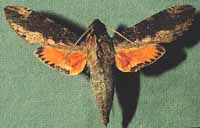 |
This species is more likely to occur as a rare stray
rather than as a breeding resident.
If present at all, it would be seen later in the season, July-August. |
 |
The abdomen has very distinct gray and black bands. It is
now recorded from Ventura.
Adults nectar at dusk so you may see them in the garen at that time. |
 |
During the night adults nectar at flowers, including bouncing bet
(Saponaria officinalis) and Asystasia gangetica beginning at dusk.
July and August are flight times in the southern states.
|
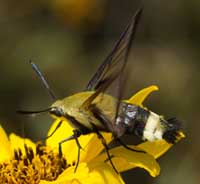 |
Hemaris thetis USGS/TD, the Thetis Clearwing or Bee Hawk Moth,
The moth flies along forest edges and in meadows, gardens and
brushy fields. Day-flying adults nectar at lantana, dwarf bush honeysuckle,
snowberry, orange hawkweed, thistles, lilac, Canada violet, etc.
|
Philampelini Tribe:
 |
This moth is now recorded for Ventura County,
and should be present wherever grapes are found.
Fight would be from June to August. Larvae feed on grape foliage. |
Macroglossini Tribe:
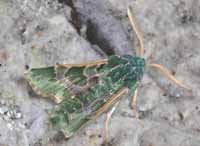 |
Arctonotus lucidus
WO/PMJ/TD, the Pacific Green
Sphinx Moth or Bear SphinxThis species is now confirmed in Ventura
County by Peter M. Jump via Tom Dimock.
January 14, 2006 sighting
was the third specimen in a week at Peter's house in the Upper Ojai
Valley. |
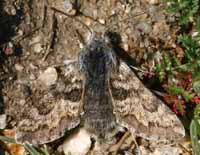 |
Euproserpinus euterpe adults fly in pastures and fallow fields
as a single brood from late January-February-April. They nectar at
flowers of filaree (Erodium) and Nemophila during the
warm parts of the day.
This species is listed as "threatened" in its known range. |
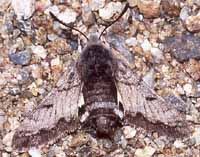 |
Adults nectar at flowers during the warm parts of the day.
Euproserpinus phaeton adults fly swiftly and close to the ground over
dry washes and flat areas in deserts as a single brood from
February-April.
|
 |
Hyles lineata
WO/TD,
the White-lined Sphinx
Adults usually fly at dusk, during the night, at dawn, and during the
day. Moths nectar at salvia and oviposit on Epilobium cana (California fuchsia) and
Hooker's Evening Primrose in nearby LA county. |
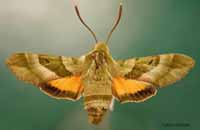 |
Adults fly in the afternoon from April-June in oak woodland and
pine-oak woodland in foothills, nectaring from chia, heartleaf
milkweed, golden currant, bluedicks, fairyfans, vetches,
thistles, hedgenettles, etc. |
|
|
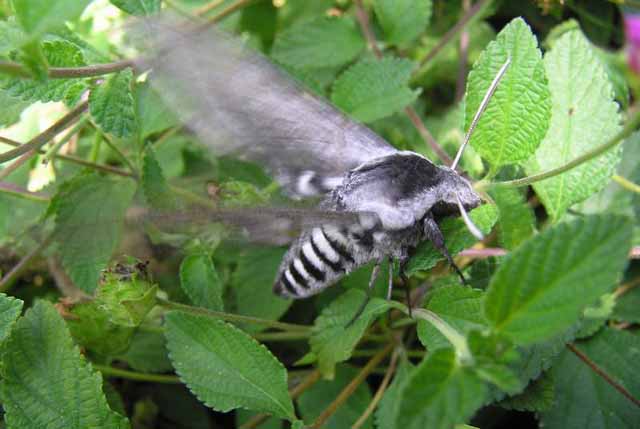
Sphinx perelegans *, August 1, 2004,
courtesy of Mary Shepherd
Thanks to Mary's care, the moth survived the bird attack, and now it prepares for flight.
Tom Dimock of Ventura, California writes (June 3, 2005):
"I have the following records for
Sphingidae from Ventura County. All are in my collection except as
noted.
7775 Manduca sexta La Conchita 20 Ft. 28 Sept 1989 Ex-larva
7776 Manduca quinquemaculata Apache Canyon 3600 Ft. 27 June 1997
7802 Sphinx chersis Howard Creek 200 Ft. 11 June 1964
7803 Sphinx vashti Pine Mt. 6750 Ft. 10 June 1999
7805 Sphinx perelegans Howard Creek 3200 Ft. 11 June 1964
7814 Sphinx sequioae Apache Canyon 3600 Ft. 1 June 1996
7822 Smerinthus cerisyi Foster Park 220 Ft. 5 Sept 1983 Ex-larva
7829 Pachysphinx occidentalis Sespe Creek 3490 Ft. 29 June 1996
7834 Erinnyis ello Ventura City 180 Ft. 6 Sept 1983
7855 Hemaris diffinis Tule Creek 3750 Ft. 7 June 1964
7861 Eumorpha achemon Piru 700 Ft. 30Aug 1991 Ex-larva
7881 Euproserpinus euterpe Cuyama Valley March 2005: larva
site record by Peter M. Jump.
7894 Hyles lineata Ventura City 180 Ft. 1 July 1991
I know of no records for Euproserpinus phaeton for Ventura
County. The closest phaeton gets to Ventura County is in the western
Antelope Valley in Los Angeles Co. If it were to be found anywhere
in Ventura Co., I suspect it would be near Frazier Park, west of
Interstate 5. Most of that area is now Kern Co., however, as the
county lines were adjusted for Kern Co. to take control of the
Frazier Park community.
I believe Peter Jump also has a Ventura Co. record for Arctonotus
lucidus, but I'll have to verify it." Now, January 2006, confirmed!
Enjoy some of nature's wonderments, giant silk moth cocoons.
These cocoons are for sale winter and fall. Beautiful Saturniidae moths will emerge the following spring and summer.
Read Actias luna rearing article. Additional online help available.
Use your browser "Back" button to return to the previous page.
This page is brought to you by
Bill Oehlke and the
WLSS. Pages are on space rented from Bizland. If you would like
to become a "Patron of the Sphingidae Site", contact Bill.
Please send sightings/images to Bill. I will do my best to respond to
requests for identification help.
 | 
Show appreciation for this site by clicking on flashing butterfly to the left.
The link will take you to a page with links to many insect sites. |



